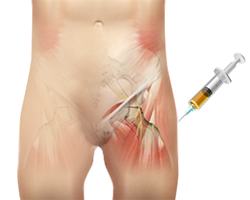Platelet-rich plasma injection is a revolutionary new treatment for treating injuries or conditions of the hip. Platelet rich plasma (PRP) is concentrated portion of blood plasma enriched with platelets or containing more amounts of platelets. Blood plasma contains vital growth factors that help in repairing the injured tissue and platelets contain Vitamin K that plays a major role in formation of blood clot.

Some of the conditions treated with PRP include Iliotibial band tendinitis (ITB Syndrome), psoas tendinitis and bursitis, greater trochanteric bursitis, labrum tears, arthritis, and sacroiliac joint dysfunction.
The tendons and ligaments have very poor blood supply and will delay the time of healing. Injection of PRP results in accumulation of excessive amounts of platelets at injured site. Platelets degranulate releasing several growth factors and cytokines which stimulate one or more phases of tissue regeneration.
In this procedure the blood is drawn from your body and centrifuged to separate blood plasma (liquid separated on top) and blood products (settled at the bottom). The plasma is taken and kept aside in a sterile injection. This is later injected in a sterile environment into the site of injury to reduce pain. An ultrasound is done by the physician to find out the actual place of injury. This will form blood clot and help in degranulation of platelets which releases the growth factors to the site of injury. These growth factors associate with other blood cells (monocytes, neutrophils, fibroblasts) which help in the healing the injury.
PRP therapy uses our own blood. Hence the treatment is associated with minimal or no risk factors, or contraindications. However, it is also used in the formation of bone in cases of fractures which helps in the formation of new bone tissue. It helps in patients being active however is limited to activities like swimming and biking.
